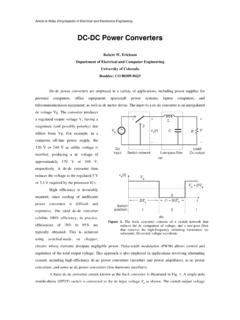Transcription of Introduction to Optical Communication Systems
1 Chapter 1 Introduction to OpticalCommunication SystemsThe purpose of this chapter is to give an overview and a somewhat historical perspective on the field ofoptical communications. The first section of the chapter describes why there are fundamental reasons thatoptics is attractive for use in communications. Indeed, the worldwide telephone network, the world s largestcommunications system , is fiber optic-based. Further, optics is finding progressively more communicationsapplications by the day, not to speak of the numerous sensing applications that are presently being imple-mented. In some areas, optics is being implemented somewhat more slowly than originally predicted. Thisis in great part due to cost. In the telephone network, hardware cost was really not an issue compared to amyriad of other costs such as right of way and cable installation, and the initial implementations were carriedrapidly rather than cost-effectively.
2 The telecommunications solutions, which were the first to be carriedout, could therefore not be taken over directly into other applications. Now, though, the telecommunicationsmarket is competitive as are the data communications market and others, and various new cost-effective so-lutions are appearing. There are numerous applications where optics is competing. The second section ofthis chapter discusses a very general Systems model which can be used to describe essentially any opticalsystem in use at present. The third, fourth, and fifth sections give a somewhat historical perspective onthe development of the three most important system components, the source, the fiber, and the 6 gives a more broad Systems The Electromagnetic Spectrum and What It Tells Us aboutthe Relative Advantages of Optical CommunicationsVarious observations relating to the potential of Optical technology for transmission of information can bemade from perusal of the frequency line of Table The information rates in which one is interestedin conventional modern-day communications Systems generally correspond to audio rates (or multiplesthereof) in telephone Systems , radio rates (or multiples thereof) in commercial broadcast Systems , or digitaltelevision rates (or multiples thereof) in the most advanced of video distribution Systems .
3 These rates (usinga digital television rate of 140 Mbit/sec times perhaps 30 channels) are generally below several one were to transmit such information without impressing it on an Optical carrier but instead on a radiofrequency (RF) carrier a bit higher than the maximum rate, the transmission wavelength of the RF carrierwould be centimeters or larger. There can, however, be great advantages to using Optical carriers. An obviousone is the low loss and directionality of the Optical fiber. Clearly, the carrier must have a higher rate thanthe information rate. A major principle that has, to present, appeared in communications Systems has beenthat the higher the frequency, the greater the technical complexity. Microwaves are harder to handle thanare radio waves. As wavelengths decrease to approach the size of circuit components, circuit elements are nolonger lumped as such, and leads can act as reflective components and/or antennas and lumped elements as1 CHAPTER 1.
4 Introduction TO Optical Communication SYSTEMS2 300km300m30cm3mm30 m30 Anameaudioradio wave mmwaveIROPT/UVx-raygamma 10310610910111013101510171020 KHzMHzGHzTHz p3 MeVTable : A frequency line which gives the wavelengths , the frequencies , and the photon energiesh forthe various regions of the frequency spectrum named on the resonators (as will be discussed further in Chapter 4). This has generally meant that sendingmore information would cost more and that there was therefore, in some sense, a cost per bit/sec (bps) oftransmitted information in the sense that going to a higher information rate requires a higher , the first observation from the frequency line would be that, for Optical carriers, which have frequenciesin the hundreds of terahertz, information bandwidth is in some sense free. That is to say, the opticalwavelength is so small compared to most devices that the technology has changed drastically from electricaland we assume that we have such technology, then no matter how high an informationrate one might want it will not be necessary to change the carrier, as the carrier frequency is higher than anyrealistic information rate could become.
5 Bandwidth is not completely free, though, as encoders and decodersmust necessarily operate at the information rate, but much of the rest of the system must necessarily handleonly the carrier plus modulation. If a component can handle a frequency of 5 1014hertz, an informationshift in that frequency of a part in a thousand (corresponding to a 500 gigahertz information rate) will havelittle or no effect on device performance. Therefore, once the system is already set up, one can upgradesystem speed more or less at will without the kind of costs incurred by changing the electromagnetic ( ) carrier in conventional Systems . (This is not quite true in long-haul communications at very highbandwidths where fiber dispersion can limit the repeaterless transmission span, but this is a rather specialcase. However, in any of the non dispersion-limited links, active efforts to increase throughput as trafficincreases are being employed.)
6 As will be mentioned below, important cases of these are (dense) wavelength-division multiplexing (DWDM to be discussed in section of Chapter 11) and code-division multipleaccess (CDMA to be discussed in section of Chapter 13).)A consequence of the size of the Optical bandwidth is that the Optical carrier can be used to carry manydifferent telephone conversations, television programs, etc., simultaneously. The process by which this isgenerally carried out (at least in synchronous format) is called time division multiplexing (TDM). The ideais that, if one wishes to multiplex 16 different channels each transmitting at 1 Mbps, one could performthis by dividing each bit period by 16 and then interleaving the bits into a composite 1 sec bit (1 Mbpsrate) which actually carries 16 bits of information on it. With telephone conversations representing a rate of64 kbps, the 100s of Tbps bandwidth of the Optical carrier holds great promise for TDM.
7 Of course, TDMis not the only multiplexing scheme one can imagine using. One could imagine impressing a number ofsubcarriers, spaced by perhaps some gigahertz, onto the Optical carrier. Each of these carriers could then bemodulated at an information rate and then reseparated according to their different carrier wavelengths at theoutput. Such a scheme is referred to as wavelength-division multiplexing (WDM) or subcarrier modulation,depending on the implementation. Many of the present-day schemes for increasing link throughput withincreasing traffic involves combining many TDM d signals onto WDM d carriers. In fact, the limitation ondensity of WDM turns out to be not bandwidth but power. That is, each channel requires some amountof power. The more channels, then, the higher the power requirement. At some power level, Optical fibernonlinearity becomes important, and this nonlinearity tends to mix the signals together.
8 There is presentlymuch effort going on in trying to find ways to equalize such 1. Introduction TO Optical Communication SYSTEMS3 The high carrier frequency of the Optical carrier also has some drawbacks, especially as it relates, throughthe speed of light, to the Optical wavelength (Table ). The Optical period corresponds to less than twofemtoseconds. This means that phase control corresponds to manipulation of subfemtosecond periods oftime. Although techniques to do such are emerging, they are complicated much more complicated thanmanipulating microwave or radio frequency waveforms. For this reason, coherent Optical reception is stilla laboratory technology. The development of the rare earth-doped Optical fiber amplifier seems, for thepresent at any rate, to have obviated the need for coherent techniques in telecommunication as far asimproved signal-to-noise ratio goes (as will be discussed in section of Chapter 11).
9 The short period of the Optical wave also implies a short wavelength centered around a half of a smallness of the Optical wavelength, therefore, promises to allow for the miniaturization of transmit andreceive modules, which should allow considerable reduction in size, weight, and cost of Optical communica-tion Systems with respect to microwave/radio wave counterparts. Oneneeds to be careful about the sizescaling, however. Although the ratio of the Optical to the microwave wavelength is roughly 10 5, waveguidedimensions do not quite scale with this factor. A fully metallic (closed) waveguide must always have adimension of roughly /2. This is not the case with fully dielectric waveguides such as the ones necessaryfor Optical fibers or integrated Optical devices. The smallness of the Optical wavelength dictates the use ofdielectric guides, as even a tiny metallic loss per wavelength would incur a huge loss over propagation dis-tances of millions to billions of wavelengths.
10 In this dielectric waveguide case, the waveguide core dimensionis /(2NA), where NA is the numerical aperture. The numerical aperture is directly related to the indexcontrast between the core and cladding of the dielectric waveguide. By nature, the index contrast must below, as if it were not, this would indicate that there was a big difference between the core and claddingmaterial, which would naturally lead to a large scattering loss. A typical NA of leads to waveguides witha characteristic dimension of about 5 , or a factor of 10 larger (per wavelength) than a metallic waveguidecounterpart if one could be made to propagate light. This factor of ten would mean that Optical dielectricwaveguides could still be a factor of roughly 104smaller than a microwave guide. Actually, the differencewith electrical is yet smaller. Microstrip and coplanar waveguide circuits are open waveguides combiningmetal and dielectric characteristics.












